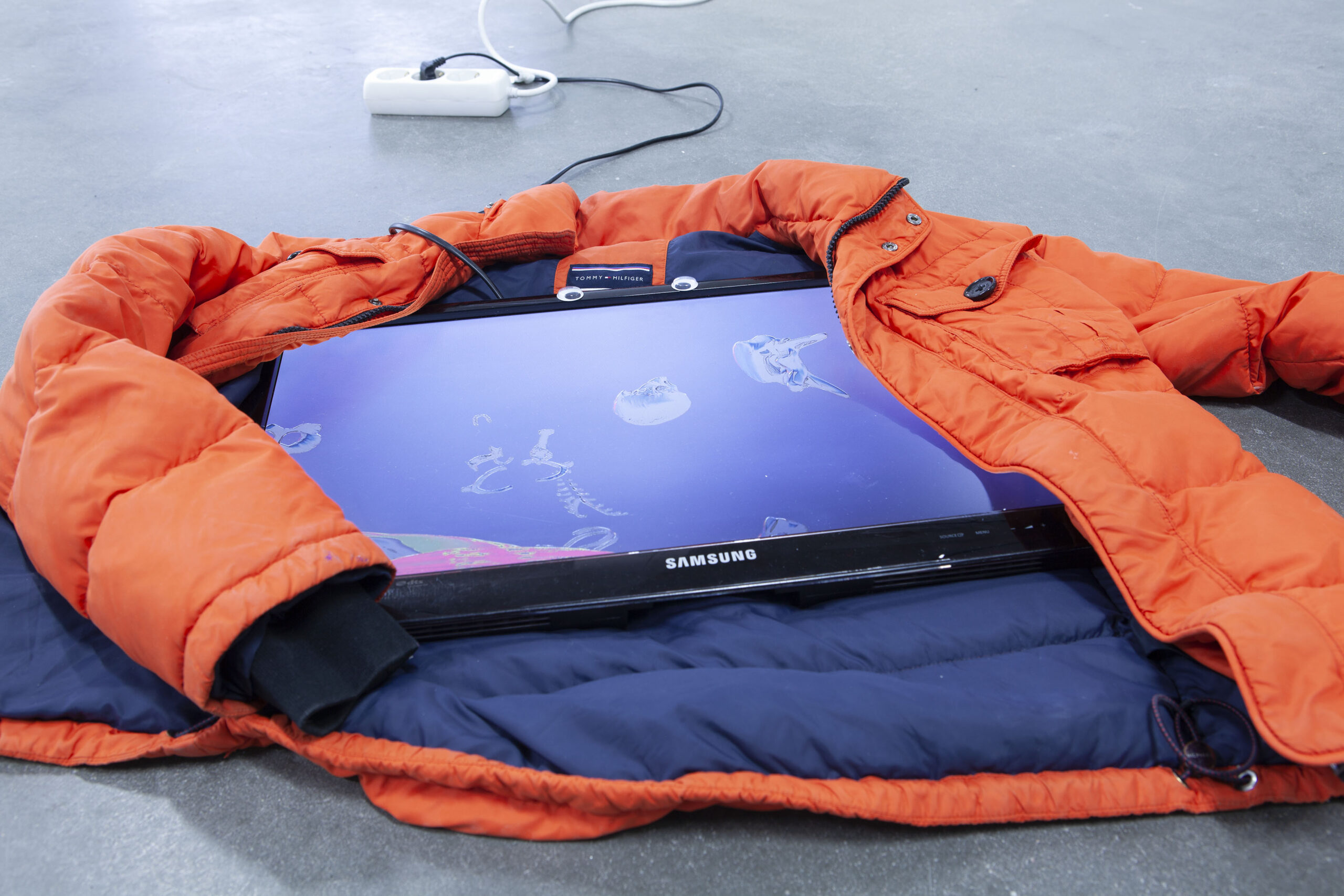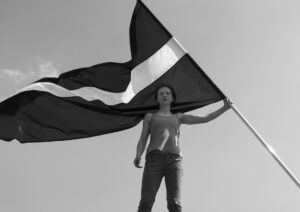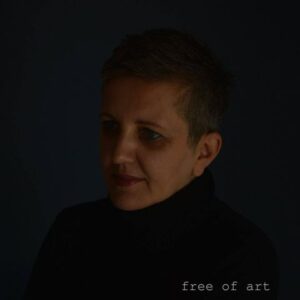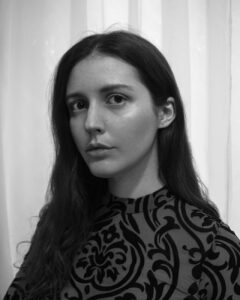Olga Krykun/Ольга Крикун

– born 1994. She received her bachelor’s degree at UMPRUM in the studio of supermedia and continued her master’s studies, also at UMPRUM, in the studio of painting. She completed her studies in 2021 and her thesis Remembering the Old World was nominated for the StartPoint Prize. During her studies at UMPRUM she completed international internships at the National Taiwan University of Arts, the University of Arts, Crafts and Design in Stockholm and T.E.I. in Athens. Olga Krykun’s main media interests are video, painting and object. In her works she combines elements of storytelling with contemporary cultural and social symbols to create her own contemporary mythology. He works with themes such as identity, the fragmentation of society, inner tension and fear and makes extensive use of intuition, personal experience and a large dose of emotion in his works.
I have been involved in art since I was a child. Art is strongly connected to the experience of my own identity and self-fulfillment and I can’t even imagine myself outside the creative field. However, I perceive visual arts as such more as a profession123.
For me, artwork is a long-term process, it is a mirror that reflects my own identity. Naturally my practice has changed over the years, especially in terms of medium. Before I started doing art professionally I was mainly oriented towards painting and drawing, these are also things I did as a child. I had already entered the art scene with video and installation, and over time I got into object work and eventually turned back to painting456.
For me, art is a reflection of reality, i.e. of my personal reality, but also of the collective reality of the whole society. I often work in blocks and periods that mirror what is happening in my life at that moment. My own work is mainly based on intuition, emotions and personal experiences. I work with a distinct visual stylization and a specific aesthetic, which often makes my works reminiscent of surreal visions or dreamlike trance and evokes a very suggestive viewing experience. I would like to achieve that visual art gives the audience similar feelings as music.
…
I’m not happy with the state of contemporary art right now, but I’m also not happy with the state of the contemporary world right now. I feel that we are living in a kind of transitional, crisis period of humanity. Artists have to deal with this situation somehow in a new way in their work, because the old schemes or habits don’t apply and don’t work anymore78.
Politics is a part of everyone’s life, we cannot separate our existence from the state of the world we live in. I see it as important to reflect the social situation in everyday life, which doesn’t just mean creating art that thematizes politics. If something about the political situation really concerns me, it will be clearly visible in my work. But the work, even if it is not directly about politics, is then perceived as political from the outside, often just on the basis of who I am and what positions I hold. This is something that has influenced me a lot, especially recently, and I’ve noticed that it’s quite difficult or almost impossible to separate art from politics910.
I identify strongly with my national identity. At the beginning of my career, I didn’t plan to reflect that in my work, but looking back on my work, it’s very clear that my national identity seeps through all of it. It’s also apparent from the outside; often when I show someone different cultural symbols and patterns that were important to me as a child, they immediately recognize why my art looks the way it does. I have been thematizing my native country and the situation in it since my thesis in 2021, and now during the Russian attack on the whole territory of Ukraine I will continue to deal with this topic. I also want to deal with a kind of ‘in-between space’ that is related to the huge cultural exchange within the migration waves of the last years.
I don’t think that art can change anything in the world in terms of politics or the socio-economic situation, but rather that it is there to comment sensitively on the current state of affairs and take it to the next level. But at the same time, I see art as one of the irredeemable human needs. We wouldn’t even be the same biological species without it. Art, and culture as a whole, is also a powerful personal weapon and way of dealing with things for me.
….
I grew up in a fairly feminist environment without anyone in my family being directly interested in defining feminism. It wasn’t until I was studying at UMPRUM that I came into closer contact with the feminist worldview and related topics, and I started to observe it more in my life so far or in my upbringing11. However, the idea of feminism and equality in art is, in my opinion, far from the real situation. We are still a long way from real equality in art and beyond, even though feminism made great strides in social roles in its first waves. I still observe that male artists are often perceived as geniuses around me, but women, on the other hand, have to put in much more effort to have her work seen as a real career and just a hobby. I feel that there is also a strong preconception that women are more likely to end their artistic careers because of their families, which contributes to women’s art being more of a ‘hobby’. While many art institutions have recently been emphasizing the exhibition of women and women mothers, the commercial sphere is still more about men.
The text was created in collaboration with Anežka Rucká (2022).
1Image: Olga Krykun, Remembering The World, 2021, ceramic, foto: Jakub Hajek. Courtesy of artist.2Image: Olga Krykun, Start Point Prize, 2021, installation, foto: Lenka Glisniková. Courtesy of artist.
3Image: Olga Krykun, Remembering The World, 2021, Ceramic, photo: Jakub Hajek. Courtesy of artist.
4Image: Olga Krykun, Forget me nots / НЕЗАБУДКИ / NIEZAPOMINAJKI, 2022, Installation view. Courtesy of artist.
5Image: Olga Krykun, Forget me nots / НЕЗАБУДКИ / NIEZAPOMINAJKI, 2022, Installation view. Courtesy of artist.
6Image: Olga Krykun, Forget me nots / НЕЗАБУДКИ / NIEZAPOMINAJKI, 2022, Installation view. Courtesy of artist.
7Image: Olga Krykun, Don't Panic, Galerie UM, 2019, screenshot. Courtesy of the artist.
8Image: Olga Krykun, Don't Panic, Galerie UM, 2019, Installation view, photo: Peter Fabo. Courtesy of artist.
9Image: Olga Krykun, Milica Mijajlovic, The Garden of my Hopes, ceramic, 2021. Courtesy of the artist.
10Image: Olga Krykun, Milica Mijajlovic, The Garden of my Hopes, ceramic, 2021. Courtesy of the artist.
11Image: Olga Krykun, Enjoye TV, 2019, Gallery Konstfack, photo Myrtille Vanhauwaert. Courtesy of artist.
– narozena 1994 v Oděse, Ukrajina. Získala bakalářský titul na UMPRUM v ateliéru supermédií a v magisterském studiu, taktéž na UMPRUM, pokračovala v ateliéru malby. Svá studia dokončila v roce 2021 a její diplomová práce Remembering the Old World byla nominována na StartPoint Prize. Během studií absolvovala mezinárodní stáže na National Taiwan University of Arts, na University of Arts, Crafts and Design ve Stockholmu a T. E. I. v Athénách. Olga Krykun se z hlediska média věnuje hlavně videu, malbě a objektu. Ve svých pracích kombinuje prvky vyprávění příběhů se současnými kulturními a společenskými symboly a vytváří tak vlastní mytologii současnosti. Pracuje s tématy jako je identita, fragmentace společnosti, vnitřní napětí a strach a ve svých dílech hojně využívá intuici, osobní zkušeností a velkou dávku emocí.
Umění se věnuji už od dětství. Umění mám silně spojené s prožíváním mé vlastní identity a seberealizací a nedokážu si sebe samotnou ani představit mimo tvůrčí obor. Výtvarné umění jako takové ale vnímám spíš jako profesi123.
Umělecká práce je pro mě dlouhodobý proces, je to zrcadlo, které odráží mou vlastní identitu. Má praxe se přirozeně během let proměnila, hlavně z hlediska média, než jsem se začala věnovat umění profesionálně, orientovala jsem se hlavně na malbu a kresbu, jsou to i věci, kterým jsem se věnovala ještě jako dítě. Na uměleckou scénu jsem už vstupovala s videem a instalací, postupem času jsem se dostala k objektu a nakonec jsem se přeci jen obrátila zpět na malbu456.
Umění je pro mě odraz reality, mé osobní reality, ale i kolektivní reality celé společnosti. Často pracuji v jednotlivých blocích a obdobích, které zrcadlí to, co se v ten daný moment v mém životě odehrává. Má vlastní tvorba je založena hlavně na intuici, emocích a osobních zkušenostech. Pracuji s výraznou vizuální stylizací a specifickou estetikou, díky tomu moje díla často připomínají až surreálné vize nebo snový tranz a navozují velmi sugestivní divácký zážitek. Ráda bych docílila toho, že vizuální umění dává divákům podobné pocity jako hudba.
…
Nejsem spokojená se stavem, ve kterém se nachází současné umění právě teď, ale nejsem ani spokojená se stavem, ve kterém se nachází současný svět právě teď. Mám pocit, že žijeme v jakémsi přechodném, krizovém období lidstva. Umělci a umělkyně musí s touhle situací ve své tvorbě nějak nově nakládat, protože stará schémata nebo zvyky už neplatí a nefungují78.
Politika je součástí života každého člověka, nelze oddělit svou existenci od stavu světa, ve kterém žijeme. Vnímám jako důležité v každodenním životě reflektovat společenskou situaci, což neznamená vytvářet jen umění, které tematizuje politiku. Pokud mě něco z politického dění skutečně pálí, bude to v mém díle jasně patrné. To dílo, i když třeba není přímo věnované politice, je ale potom jako politické vnímáno zvenční, často jen na základě toho, kdo jsem a jaké zastávám pozice. Tohle je něco, co mě zvlášť poslední dobou, dost ovlivnilo a pozoruji, že je dost těžké nebo skoro nemožné umění od politiky oddělit910.
Silně se ztotožňuji se svou národní identitou. Na počátku mé kariéry jsem neměla v plánu to do mojí práce nějak promítat, ale když se na svou tvorbu dívám zpětně, je úplně jasné, že má národní identita celou tou tvorbou prosakuje. Je to patrné i zvenčí, často když někomu ukazuji různé kulturní symboly a vzorce, které pro mě v dětství byly důležité, hned poznávají, proč moje umění vypadá tak, jak vypadá. Mou rodnou zemi a situaci tematizují už od diplomky v roce 2021 a teď během ruského útoku na celé území Ukrajiny se tím tématem budu zabývat dál. U toho se chci věnovat i jakémusi ,,meziprostoru”, který souvisí s obrovskou kulturní výměnou v rámci migračních vln posledních let.
Nemyslím si, že by umění mohlo ve světě z hlediska politiky nebo socioekonomické situace něco změnit, je tu spíš od toho, aby citlivě komentovalo ten současný stav a přenášelo ho do další roviny. Zároveň ale umění vnímám jako jednu z neupiratelných lidských potřeb. Bez něj bychom ani nebyli stejný biologický druh. Umění a celá kultura je i pro mě silná osobní zbraň a způsob, jak se s věcmi vypořádat.
….
Vyrůstala jsem v poměrně feministickém prostředí i bez toho, aby se někdo z mé rodiny přímo zajímal o definici feminismu. Až během studia na UMPRUM jsem se blíže potkala s feministickým pohledem na svět a s tím spojenými tématy a začala jsem to i víc pozorovat ve svém dosavadním životě nebo mojí výchově11. Idea feminismu a rovnoprávnosti v umění je ovšem podle mě vzdálená skutečnému stavu. Ke skutečné rovnoprávnosti v umění i mimo něj ještě máme daleko i přesto, že feminismus v prvních vlnách přinesl velké pokroky ve společenských rolích. Pořád pozoruji, že muži-umělci jsou kolem mě často vnímáni jako géniové, ale ženy naopak musí vynaložit mnohem větší úsilí, aby jejich tvorba byla brána jako skutečná kariéra a ne jen jako hobby. Cítím, že také silně přetrvává předstva, že žena spíš ukončí svou uměleckou dráhu kvůli rodině, což přispívá k tomu, že ženské umění je spíš ,,koníček”. Mnohé umělecké instituce v poslední době sice dávají důraz na vystavování žen a žen-matek, ale v komerční sféře se pořád víc točí kolem mužů.
Text vznikl ve spolupráci s Anežkou Ruckou (2022).
1Obrázek: Olga Krykun, Remembering The World, 2021, keramika, foto: Jakub Hajek. S laskavým svolením umělkyně.2Obrázek: Olga Krykun, Start Point Prize, 2021, instalace, foto: Lenka Glisniková. S laskavým svolením umělkyně.
3Obrázek: Olga Krykun, Remembering The World, 2021, keramika, foto: Jakub Hajek. S laskavým svolením umělkyně.
4Obrázek: Olga Krykun, НЕЗАБУДКИ / NIEZAPOMINAJKI, 2022, pohled do instalace. S laskavým svolením umělkyně.
5Obrázek: Olga Krykun, НЕЗАБУДКИ / NIEZAPOMINAJKI, 2022, Pohled do instalace. S laskavým svolením umělkyně.
6Obrázek: Olga Krykun, НЕЗАБУДКИ / NIEZAPOMINAJKI, 2022, pohled do instalace. S laskavým svolením umělkyně.
7Obrázek: Olga Krykun, Don't Panic, 2021, video screenshot, Galerie UM. S laskavým svolením umělkyně.
8Obrázek: Olga Krykun, Don't Panic, 2021, video screenshot, Galerie UM. S laskavým svolením umělkyně.
9Obrázek: Olga Krykun, Milica Mijajlovic, The Garden of my Hopes, 2021, keramika. S laskavým svolením umělkyně.
10Obrázek: Olga Krykun, Milica Mijajlovic, The Garden of my Hopes, 2021, keramika. S laskavým svolením umělkyně.
11Obrázek: Olga Krykun, Enjoye TV, Gallery Konstfack, 2019, foto: Myrtille Vanhouwaert. S laskavým svolením umělkyně.



